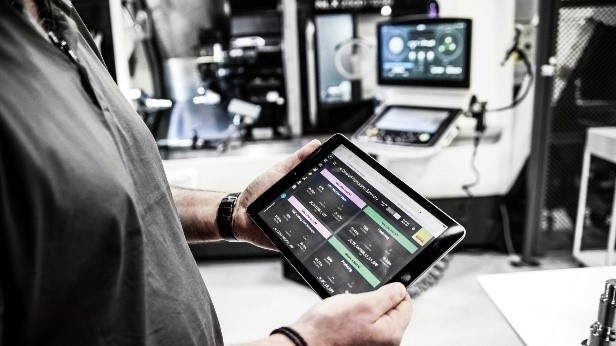Where IoT Meets Sustainability

Using smart technologies to reduce energy consumption isn’t new for the manufacturing sector, but the challenges of implementing these technologies on-site have long been a barrier to adoption. Here is a little advice to the metal cutting industry on implementing smart factory solutions—both to reduce carbon and increase profits.
The Groupe Speciale Mobile Association (GSMA) has urged industry leaders to scale up their use of smart technology in the race towards net-zero and predicts that doing so could contribute up to 40 percent of the required global emission reductions. In its research on the Internet of Things (IoT) and carbon reduction, the association estimated that in the manufacturing realm, 16 percent of the carbon reduction required to achieve net-zero could be achieved using smart manufacturing processes. That is the equivalent of 1.4 gigatonne of CO2 or the emissions of 140 million cars.
Considering these extraordinary figures, one must ask: why, in an industry that first coined the phrase ‘Industry 4.0’ over a decade ago, have smart technologies not been universally deployed? In fact, it is reported that just 1 percent of the Manufacturing industry is currently using connected technology.
The most common barrier to smart technology adoption in manufacturing is a lack of understanding of how easily these tools can be implemented. Casting our minds back to the inception of Industry 4.0—a phrase originally used at Germany’s Hannover Messe exhibition in 2011—smart factories were regarded as futuristic plants that would bear little resemblance to real manufacturing sites. Today, we understand that digitalization doesn’t necessitate an entire plant overhaul and is more often achieved incrementally through scalable IoT technologies and big data.
Gaining data using IoT
Every manufacturing facility generates huge volumes of data each day, either knowingly or unknowingly. Without question, data is the most valuable asset in manufacturers’ efforts to reduce carbon emissions. However, many manufacturers are not putting this asset to its best use. Without facility-wide data evidencing how much energy is being used and where, how can manufacturers begin their energy reduction journey?
A common misconception is that all equipment must be smart to successfully generate data. In reality, even facilities operating with decades-old legacy machinery have the potential to pull data from their production lines, and those in the industry know these plants are far more common than the futuristic smart factories imagined in Hannover in 2011. This may require a combination of sensors and intelligent software, depending on such factors as the age and original equipment manufacturer (OEM) of the equipment and the communications protocols used, but it is possible.
A core objective of CoroPlus® Process Control is to reduce consumption by reducing material waste. The tool monitors machines in real time and can trigger actions according to programmed protocols.
Gaining insight into a facility’s energy consumption is key to identifying pain points. One might discover that minor tweaks to several parts of production can yield a significant carbon reduction. However, it’s also possible that individual pieces of equipment offer the biggest room for improvement. Gaining data from these areas is crucial to reducing the energy used by individual machines, and various technologies enable manufacturers to do this.
One such solution is the CoroPlus® suite of products, part of the data-driven machining offer from Sandvik Coromant. The products are designed to help manufacturing organizations improve efficiency in metal cutting processes.
A core objective of CoroPlus® Process Control is to reduce consumption by reducing material waste. The tool monitors machines in real time and can trigger actions according to programmed protocols. Let’s imagine that a predetermined problem occurs within the equipment. With CoroPlus® Process Control, this technology will automatically start a correctional action, such as stopping the machine from avoiding further waste. Moreover, conducting maintenance using this technology has been demonstrated to improve operational efficiency by as much as 89 percent.
Energy and economics
Considering the challenges and losses manufacturers have faced during the COVID-19 pandemic, is there a risk that reducing carbon emissions will become a secondary priority behind generating the profits needed to recover? Forty-nine percent of executives surveyed in the Accenture

Commercial Aerospace Insight Report predict that it will take up to three years for the Aerospace Manufacturing sector to recover to 2019 levels. Similarly, the Automotive Manufacturing sector has experienced slumps in vehicle sales in almost every country.
It is true and valid that manufacturing economics must always be considered when investing in new tools and machining processes. However, the right technologies can help increase profits and reduce energy use simultaneously.
CoroPlus® Machining Insights, for instance, has been developed to use real-time data to inform tool optimization and, therefore, performance and profit. In a metal cutting workshop, the technology can provide instant access to data about a specific machine in order to allow operators to monitor Overall Equipment Effectiveness (OEE) and performance. Ultimately, this oversight makes manufacturing workshops more efficient and profitable.
Over a decade has passed since the phrase ‘Industry 4.0’ was first coined, and it has since become ingrained in manufacturing’s vocabulary. Yet, research suggests that, despite the impressive energy-saving opportunities this technology could facilitate, many manufacturers are failing to exploit these tools. To achieve the world’s carbon emission goals, manufacturers must make a conscious effort to reduce energy consumption. At Sandvik Coromant, we want to ensure customers can successfully implement these tools for people, profit, and the planet.

JÖRGEN FRIESENDAHL
Global Offer Manager for Data Driven Machining
Sandvik Coromant
Source: Sandvik Coromant




 Facebook
Facebook.png) Twitter
Twitter Linkedin
Linkedin Subscribe
Subscribe